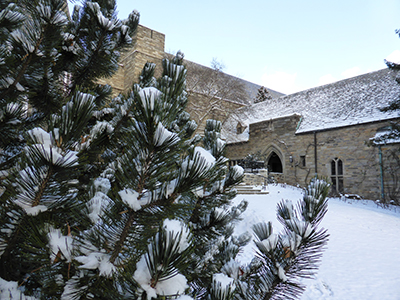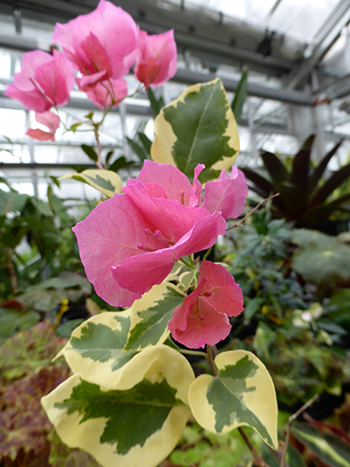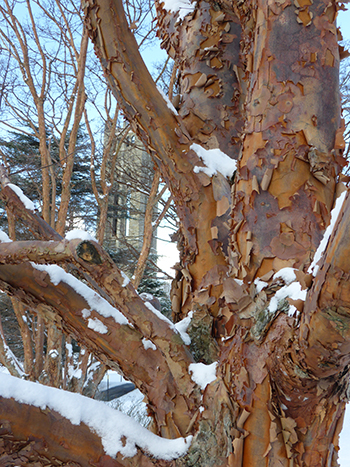Plants of the Week: January 12, 2015
 Pinus heldreichii anchors a corner planting around the Sproul Observatory building. Bosnian pine is native to dry limestone soils in mountain areas of the Balkans, Italy, and Greece where it grows to 60’ to 90′ tall. In cultivation the pine typically grows to 30’ to 40′ tall. A slow-growing evergreen with stiff upright bundles of needles, dark green in color, P. heldreichii is tightly conical in youth, maturing to a more open habit with age. The species name honors Greek botanist Theodor von Heldreich (1822-1902). Pinus leucodermis is now considered to be synonymous with this species. Photo credit: J. Coceano
Pinus heldreichii anchors a corner planting around the Sproul Observatory building. Bosnian pine is native to dry limestone soils in mountain areas of the Balkans, Italy, and Greece where it grows to 60’ to 90′ tall. In cultivation the pine typically grows to 30’ to 40′ tall. A slow-growing evergreen with stiff upright bundles of needles, dark green in color, P. heldreichii is tightly conical in youth, maturing to a more open habit with age. The species name honors Greek botanist Theodor von Heldreich (1822-1902). Pinus leucodermis is now considered to be synonymous with this species. Photo credit: J. Coceano
Garden location: Sproul Observatory
 Bougainvillea ‘Raspberry Ice’ is a profuse bloomer of raspberry pink bracts amid foliage varying from creamy white to warm pale yellow depending on sunlight intensity. While considered one of the hardiest bougainvilleas, (to zone 8), ‘Raspberry Ice’ requires overwintering protection in a frost-free environment. Despite the abundant variegation, a trait often associated with weak growth, ‘Raspberry Ice’ is a prolific grower and commonly offered for sale in the trade. Photo credit: J. Coceano
Bougainvillea ‘Raspberry Ice’ is a profuse bloomer of raspberry pink bracts amid foliage varying from creamy white to warm pale yellow depending on sunlight intensity. While considered one of the hardiest bougainvilleas, (to zone 8), ‘Raspberry Ice’ requires overwintering protection in a frost-free environment. Despite the abundant variegation, a trait often associated with weak growth, ‘Raspberry Ice’ is a prolific grower and commonly offered for sale in the trade. Photo credit: J. Coceano
Garden location: seasonal warm-weather plantings, overwintered in the Wister Center Greenhouses
When it comes to exfoliating bark, it’s hard to top Acer griseum. The paperbark maple is native to central China and was originally introduced to the United States by E. H. Wilson in 1901, through the Arnold Arboretum. It is thought that all plants in the United States are progeny from Wilson’s initial collection. Recent plant collecting trips to China have found various Acer griseum populations. Collected seed will hopefully enrich and expand the genetic diversity of this garden staple. Photo credit: J. Coceano
Garden location: Eastern side of Sharples Dining Hall






No Comments